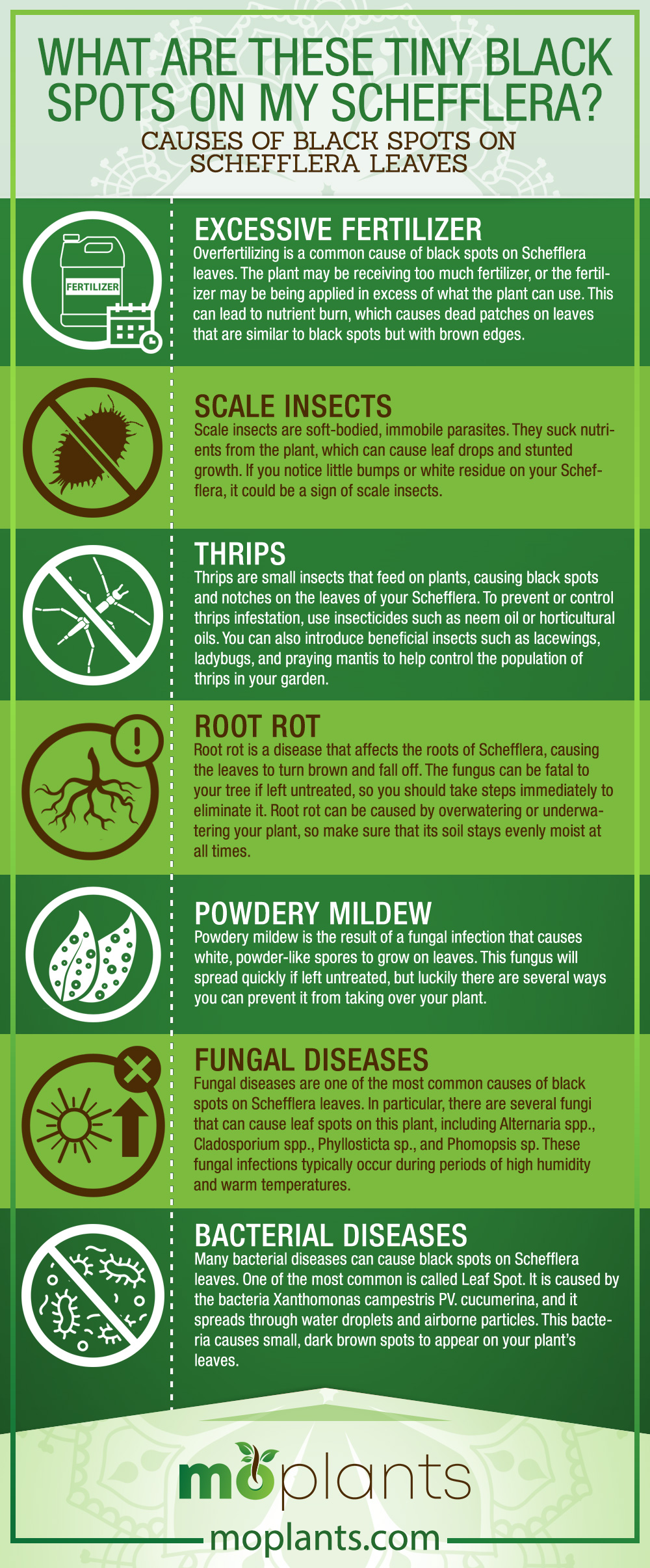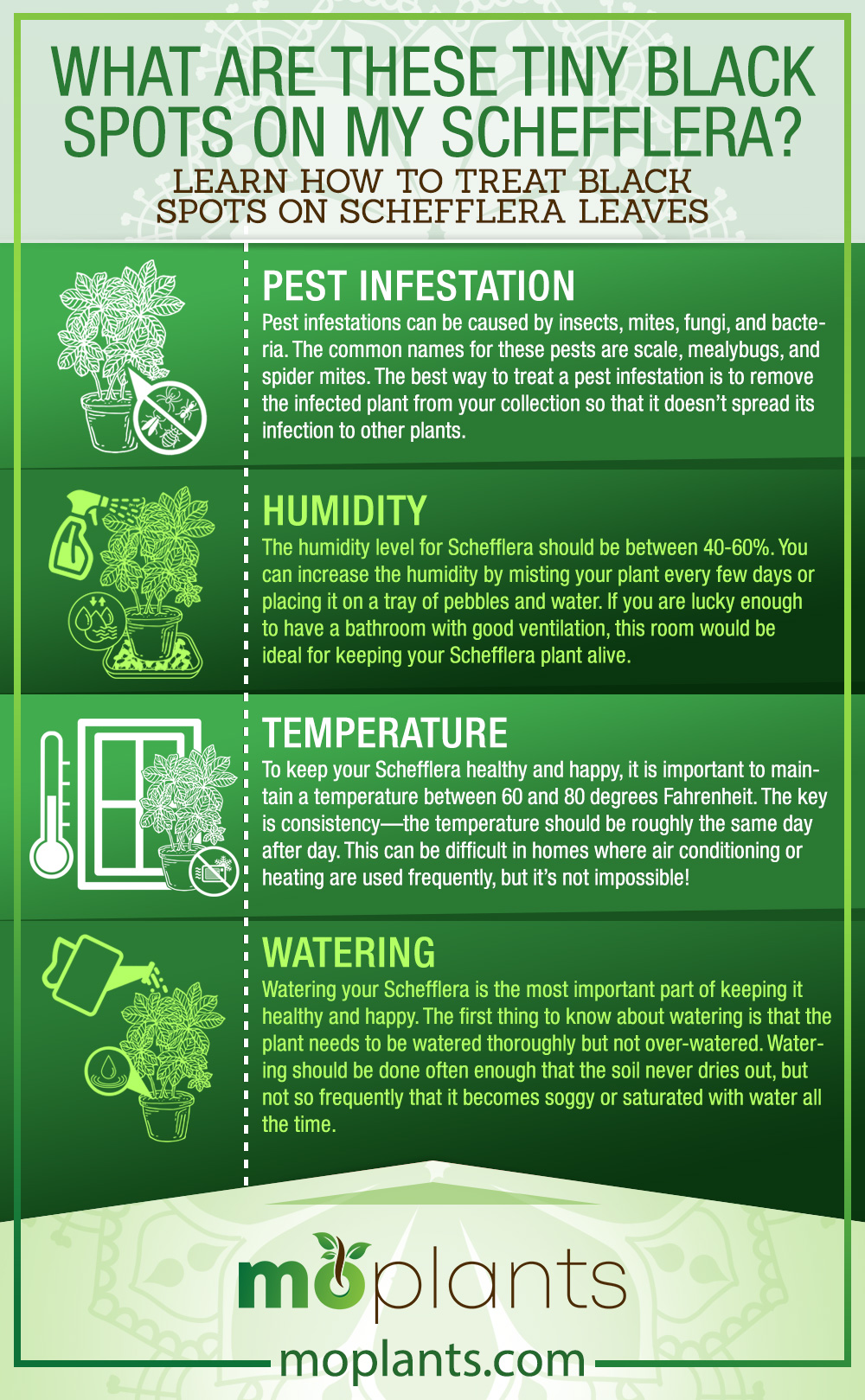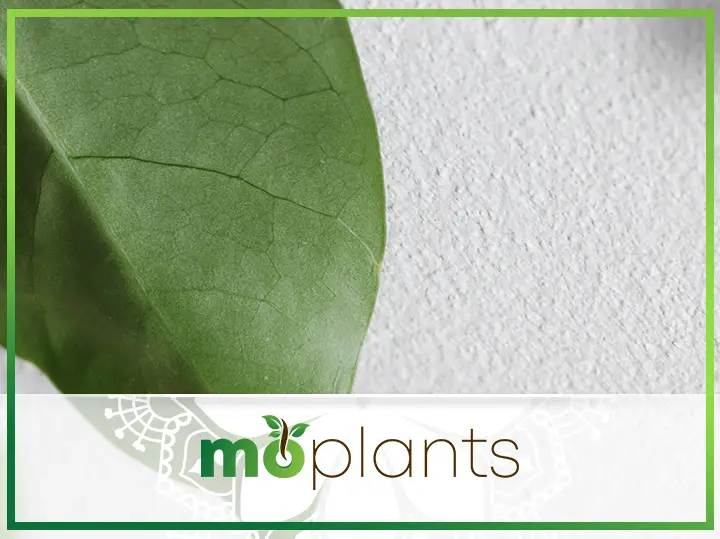- Black Spots On Schefflera Leaves
- Causes Of Black Spots On Schefflera Leaves
- Excessive Fertilizer
- Scale Insects
- Thrips
- Root Rot
- Powdery Mildew
- Fungal Diseases
- Bacterial Diseases
- Treating Black Spots On Schefflera Leaves
- How To Treat Fungal Diseases Of Schefflera?
- Treatment For Bacterial Diseases Of Schefflera
- Learn How To Treat Black Spots On Schefflera Leaves
- Pest Infestation
- Humidity
- Temperature
- Watering
- Our Final Thoughts
A number of different things can cause black spots on Schefflera leaves. These symptoms often appear on the new growth tips, which are more delicate than the older leaves. If you have black spots on your Schefflera plant, it’s important to determine what is causing them so that you can properly treat the problem.
Black Spots On Schefflera Leaves
If you see black spots on your Schefflera leaves, don’t panic! It’s a common problem that is usually easy to fix.
Black spots on leaves are not always a sign of disease. In fact, they’re normally caused by insects or mites and can be easily treated.
Causes Of Black Spots On Schefflera Leaves
So you have a beautiful Schefflera plant, and one day, you notice that several leaves are discolored. You might have several questions buzzing through your head – what causes these black spots on Schefflera leaves? Are they dying? Will the whole plant die?
Many different things can cause black spots on Schefflera leaves. However, it is important to find the cause so you can treat it and save your plant.
Excessive Fertilizer
Overfertilizing is a common cause of black spots on Schefflera leaves. The plant may be receiving too much fertilizer, or the fertilizer may be being applied in excess of what the plant can use. This can lead to nutrient burn, which causes dead patches on leaves that are similar to black spots but with brown edges. Excessively fertilized plants will also experience root rot, resulting in browning and lower stems wilting.
If you are using liquid fertilizers, apply them at half strength every two weeks during the growing season (spring through fall). If using granular slow-release organic fertilizers instead, consider cutting back the amount used by 50 percent in late winter/early spring before new growth begins.
Scale Insects
Scale insects are soft-bodied, immobile parasites. They suck nutrients from the plant, which can cause leaf drops and stunted growth. If you notice little bumps or white residue on your Schefflera, it could be a sign of scale insects.
To get rid of them:
- Clean off any leaves or branches with a stiff brush to dislodge any eggs and adults; then spray the area with an insecticide such as horticultural oil (which suffocates them) or neem oil (which kills them). Be sure to read the label directions before using these products!
Thrips
Thrips are small insects that feed on plants, causing black spots and notches on the leaves of your Schefflera. To prevent or control thrips infestation, use insecticides such as neem oil or horticultural oils. You can also introduce beneficial insects such as lacewings, ladybugs, and praying mantis to help control the population of thrips in your garden.
Root Rot
Root rot is a disease that affects the roots of Schefflera, causing the leaves to turn brown and fall off. The fungus can be fatal to your tree if left untreated, so you should take steps immediately to eliminate it. Root rot can be caused by overwatering or underwatering your plant, so make sure that its soil stays evenly moist at all times.
Powdery Mildew
Powdery mildew is the result of a fungal infection that causes white, powder-like spores to grow on leaves. This fungus will spread quickly if left untreated, but luckily there are several ways you can prevent it from taking over your plant.
- Avoid overwatering. When your plant needs water, give it enough to ensure the soil is moist throughout its root system. If the roots stay wet for too long, they’re more susceptible to mold and other diseases, which can spread quickly through a Schefflera’s large canopy of leaves.
- Keep air flowing around your plant by rotating it every few days so that each leaf has equal access to air circulation (which will help prevent mold spores from settling on them!)
Fungal Diseases
Fungal diseases are one of the most common causes of black spots on Schefflera leaves. In particular, there are several fungi that can cause leaf spots on this plant, including Alternaria spp., Cladosporium spp., Phyllosticta sp., and Phomopsis sp. These fungal infections typically occur during periods of high humidity and warm temperatures. The best way to control fungal diseases is to maintain healthy growing conditions for your Schefflera plant by keeping it in a sunny location with well-drained soil and proper watering.
Bacterial Diseases
Many bacterial diseases can cause black spots on Schefflera leaves. One of the most common is called Leaf Spot. It is caused by the bacteria Xanthomonas campestris PV. cucumerina, and it spreads through water droplets and airborne particles. This bacteria causes small, dark brown spots to appear on your plant’s leaves.
Another bacterial disease that causes black spots on Schefflera leaves is Phytophthora blight, which is caused by a fungus called Phytophthora cinnamomi. The disease starts as small spots on the leaves but will eventually turn into large brown patches that cover much of the leaf surface area. This fungus can be introduced into your indoor environment when you bring home new plants, especially if those plants have been exposed to wet conditions outside.
Infographic

Treating Black Spots On Schefflera Leaves
Remove all infected leaves and prune away diseased branches if the plant is infected. Make sure you wash the plant with a strong jet of water to remove as many spores as possible.
If black spots are present on Schefflera leaves, spray the plant with an antifungal or bactericidal fungicide to kill off any remaining spores that could cause further growth. Spraying your Schefflera tree with a systemic insecticide can also help prevent future infestations by killing off pests like spider mites and scale insects.
How To Treat Fungal Diseases Of Schefflera?
If the fungus has infected your Schefflera, you should remove infected leaves and any other parts of the plant that are affected. You can also spray a fungicide on the plant to help treat it. Some examples of suitable fungicides include:
- Bordeaux mix (mixture of copper sulfate and hydrated lime)
- Copper oxychloride
- Captan (systemic)
- Benomyl (systemic)
Treatment For Bacterial Diseases Of Schefflera
If you suspect your Schefflera is suffering from a bacterial disease, it’s important to act fast. The best way to start is by getting rid of dead or dying leaves and then watering them with lukewarm water diluted with half-strength fungicide. You can also apply potassium bicarbonate solution directly onto the infected areas and repeat this process every two weeks until the problem clears up.
Learn How To Treat Black Spots On Schefflera Leaves
The Schefflera plant is a common houseplant that you may have seen in your local nursery. It’s easy to take care of and can grow up to six feet tall! Its leaves are often green and shiny, but sometimes they will turn black from pests or other problems. You may notice that the tips of your plant’s leaves are turning brown or black, which is not normal for this type of plant. Here are some reasons why this happens:
Pest Infestation
Pest infestations can be caused by insects, mites, fungi, and bacteria. The common names for these pests are scale, mealybugs, and spider mites.
The best way to treat a pest infestation is to remove the infected plant from your collection so that it doesn’t spread its infection to other plants. If you want to try an organic approach first (and save your hard-earned money), soak a paper towel in water mixed with baking soda and wrap the mixture around the leaves of your Schefflera; this may help suffocate any insects on its leaves. Then you can clean the leaves with a cotton swab dipped in rubbing alcohol or insecticidal soap spray (be sure that it’s labeled safe for use on houseplants).
One way of preventing future problems is by keeping them in their own pot instead of sharing one pot with other houseplants; this makes it easier for you to monitor any potential problems as they arise instead of having them spread through shared pots full of soil that could infect all other plants in close proximity at once!
Humidity
The humidity level for Schefflera should be between 40-60%. You can increase the humidity by misting your plant every few days or placing it on a tray of pebbles and water. If you are lucky enough to have a bathroom with good ventilation, this room would be ideal for keeping your Schefflera plant alive.
Temperature
To keep your Schefflera healthy and happy, it is important to maintain a temperature between 60 and 80 degrees Fahrenheit. The key is consistency—the temperature should be roughly the same day after day. This can be difficult in homes where air conditioning or heating are used frequently, but it’s not impossible! It may help to place your plant near a window that gets direct sunlight in the morning hours (when the sun is at its hottest), then move it away from that window once evening hits. Also, avoid drafts and heaters as much as possible; if you must use them nearby, make sure all of their vents are pointed away from your Schefflera’s leaves.
Watering
Watering your Schefflera is the most important part of keeping it healthy and happy. The first thing to know about watering is that the plant needs to be watered thoroughly but not over-watered. Watering should be done often enough that the soil never dries out, but not so frequently that it becomes soggy or saturated with water all the time.
Schefflera, like to be watered in the morning or evening when temperatures are cooler than during the heat of midday sun exposure.
Infographic

Our Final Thoughts
We hope this article has helped you understand more about the causes and treatment of black spots on Schefflera leaves. Hopefully, you now better understand what causes black spots on Schefflera leaves and what to do about them. If you notice any other problems with your Schefflera plant, take a look at our other articles on how to care for it! Remember that it’s important to check with a professional before making any drastic changes to your home’s environment. Sometimes the problem isn’t in the plant itself, but rather something environmental that needs to be corrected first.

